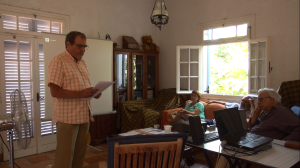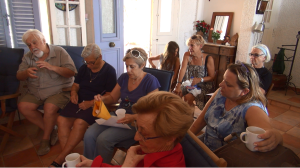Ανοιχτή επιστολή προς τον Γιάνη Βαρουφάκη:
Το σχέδιο Β λέγεται δημοκρατία
των Thomas Coutrot (οικονομολόγος, επιστημονική επιτροπή Attac Γαλλίας) και Bruno Théret (οικονομολόγος, διευθυντής ερευνών, Εθνικό Κέντρο Επιστημονικών Ερευνών – CNRS)
Αγαπητέ Γιάνη Βαρουφάκη,
Επί πέντε μήνες ήσασταν η ζωντανή έκφραση των ελπίδων πολλών ευρωπαίων πολιτών. Προσφέρατε έναν αέρα διανοητικής ειλικρίνειας και αυστηρότητας στον κύκλο των γκρίζων ανθρώπων του Eurogroup. Προσπαθήσατε με πείσμα να τηρήσετε τον λόγο σας απέναντι στους έλληνες ψηφοφόρους: να βάλετε τέλος στην λιτότητα παραμένοντας στο ευρώ. Αλλά τέλη Ιουνίου τα ζόμπι του Eurogroup και του Συμβουλίου, ενισχυμένα από την απομόνωση της Ελλάδας και ασθενή κινήματα αλληλεγγύης στην Ευρώπη, σας έστειλαν ένα τελεσίγραφο: υποκύψτε η εγκαταλείψτε το εrafυρώ.
Η νίκη του «ΟΧΙ» στο δημοψήφισμα της 5 Ιουλίου ενίσχυσε την νομιμοποίηση της άρνησης σας των απαιτήσεων των δανειστών. Στις 13 Ιουλίου γνωστοποιήσατε (1) την πρόταση που κάνατε στον Αλέξη Τσίπρα την νύχτα του δημοψηφίσματος, « ένα τρίπτυχο δράσεων» για την αποφυγή της υποταγής: «έκδοση IOUs» (αναγνωρίσεων οφειλής σε ευρώ ήτοι ένα συμπληρωματικό νόμισμα που θα βασίζεται σε μελλοντικά φορολογικά έσοδα), «ένα κούρεμα των ελληνικών ομολόγων» που κατέχει η ΕΚΤ από το 2012 για την μείωση του χρέους και την «την θέση υπό έλεγχο της Τράπεζα της Ελλάδος που ελέγχεται από την ΕΚΤ.» Αλλά ο Αλέξης Τσίπρας απέρριψε το σχέδιο αυτό και δέχθηκε την παραίτηση σας.
Στις 20 Ιουλίου, στο Ελληνικό Κοινοβούλιο αρνηθήκατε να πάτε να υπερψηφίσετε την Συμφωνία της 13 Ιουλίου παρατηρώντας αυτό το καίριο σημείο: “όταν οι κοινωνία θα αρχίσει να νοιώθει στα σπλάχνα της τις καταστροφικές συνέπειες του νέου σχεδίου λιτότητας, “όταν οι νέοι και οι ηλικιωμένοι θα βγουν στους δρόμους η θα μείνουν απελπισμένοι στα σπίτια τους, αντιμέτωποι αυτών των συνεπειών, ποιος θα αντιπροσωπεύει όλους αυτούς των οποίων ήμασταν ως τώρα η φωνή στον πολιτικό χώρο;”
Η ενότητα του ΣΥΡΙΖΑ, ένα εργαλείο που με υπομονή έχτισε η ελληνική αριστερά, είναι πολύτιμη. Αυτό εξηγεί μάλλον που δεν ηγηθήκατε της συζήτησης επί των εναλλακτικών σας προτάσεων. « Υπήρχε εναλλακτική λύση; με ρώτησε ο πρωθυπουργός την περασμένη Τετάρτη. Πιστεύω ότι ναι, υπήρχε. Αλλά δεν θα πω περισσότερα. Δεν είναι στιγμή να το συζητήσουμε. Το σημαντικό είναι ότι το βράδυ του δημοψηφίσματος ο πρωθυπουργός είπε ότι δεν υπήρχε εναλλακτική λύση.»
Ωστόσο η απόφαση του Αλέξη Τσίπρα να υποκύψει, και, χειρότερα ακόμα, να υλοποιήσει ο ίδιος τις απαιτήσεις των δανειστών, είναι τραγική. Όπως και σεις είμαστε τρομοκρατημένοι από τιε πολιτικές συνέπειες της 13 Ιουλίου. Η ριζοσπαστική αριστερά που ήρθε στην εξουσία και της οποίας η νομιμοποίηση να βάλει τέλος στη λιτότητα επιβεβαιώθηκε μέσω του δημοψηφίσματος, εμφανίστηκε όχι μόνο ανίκανη να αρνηθεί ένα σχέδιο λιτότητας που καταστρέφει την δημοκρατία, αλλά και διεκδικεί να το διαχειριστεί η ίδια. Ακόμα και αν δεν υπάρχει άλλη επιλογή βραχυπρόθεσμα, η επιστροφή στην αντιπολίτευση, όπως την επιθυμήσατε, θα ήταν προτιμότερη για το μέλλον της.
Αν όμως ένα σχέδιο Β ήταν εφικτό, όπως το πιστεύετε, τότε το λάθος είναι ακόμα πιο τραγικό. Αυτή η κρίσιμη συζήτηση αναπτύσσεται σήμερα εντός της Ευρωπαϊκής Αριστεράς. Η Αριστερή Πλατφόρμα του ΣΥΡΙΖΑ είχε προτείνει στις 24 Μαΐου η παύση πληρωμών και την κρατικοποίηση των τραπεζών. Ο Éric Toussaint υπέβαλε στις 13 Ιουλίου ένα πιο εκτενές κατάλογο μέτρων (2) αναγνωρίζοντας ότι, όπως φαίνεται, η απόρριψη της λιτότητας επιβάλει την υιοθέτηση αναγκαίων και επειγόντων μονομερών ενεργειών που σίγουρα θα θεωρηθούν ως ενδείξεις ανυπακοής από τους σημερινούς ηγέτες της ΕΕ, ακόμα και αν δεν αντιβαίνουν υποχρεωτικά στις υπάρχουσες συνθήκες (3).
Αντίθετα των όσων υποστηρίζουν αξιόλογες προσωπικότητες όπως οι Etienne Balibar, Sandro Mezzadra και Frieder Otto Wolf (4), τέτοιες εναλλακτικές προτάσεις δεν πρέπει να θεωρούνται ως « αυταρχικές και μη εφαρμόσιμες θεωρίες ‘ελέγχου’ της νομισματικής πολιτικής και των κινήσεων κεφαλαίου». Κατά τον ίδιο τρόπο μπορούμε να αντιπαραθέσουνε στην άποψη του μεγάλου κοινωνιολόγου Boaventura de Sousa Santos ότι « αν μία χώρα δείξει ανυπακοή, θα πρέπει να διωχθεί και το χάος δεν θα μπορέσει να αποφευχθεί»(5)», ότι, με δεδομένο το περιεχόμενο της « συμφωνίας» της 13 Ιουλίου, το χάος είναι εγγυημένο αν το κράτος συμμορφωθεί.
Ο Pablo Iglesias, ηγέτης του Podemos, δεν βλέπει καμία εναλλακτική επιλογή από αυτή της «συμφωνίας» της 13ης Ιουλίου, « το μόνο που μπορούμε να κάνουμε, αυτή είναι η αλήθεια της εξουσίας» (6). Αλλά αν δεν υπάρχει άλλη επιλογή, αν καμία ευρωπαϊκή χώρα δεν μπορεί να σταματήσει την λιτότητα χωρίς να βουλιάξει στο χάος – και δεν υπάρχει αμφιβολία ότι η Ισπανία, η Ιταλία και η Γαλλία θα αντιμετωπίσουν ανάλογες δυσκολίες με αυτές της Ελλάδας (7) – η νεοφιλελεύθερη παγίδα δεν αφήνει κανένα περιθώριο. Αν καμία χώρα δεν μπορεί από μόνη της να κάνει ένα βήμα διαφορετικό και να πάρει ένα διαφορετικό μονοπάτι για να δείξει έναν άλλο δρόμο, το μόνο που μένει είναι να κρατήσουμε ρητορικά την προοπτική μίας «άλλης Ευρώπης» περιμένοντας μία πανευρωπαϊκή πολιτική κρίση και/η μία συστημική κατάρρευση της ευρωζώνης που θα βάλει όλες τις χώρες στην ίδια μοίρα.
Επί χρόνια, με άλλους, αντισταθήκαμε σε όσους υποστήριζαν ότι η έξοδος από την ευρωζώνη είναι μία προϋπόθεση για όποια εναλλακτική πολιτική. Η εγκατάλειψη του ευρώ έχει σημαντικό οικονομικό και πολιτικό κόστος για την χώρα που το εγκαταλείπει. Επίσης η υπόδειξη της Γερμανίας σαν τον κυριότερο ένοχο, και η υποστήριξη της επιστροφή της εξουσίας σε εθνικό επίπεδο ως προϋπόθεση για οποιαδήποτε λύση, είναι ένα σημαντικό λάθος που αγνοεί την τεράστια ευθύνη όλων των εθνικών ελίτ στην διαμόρφωση της παρούσας κατάστασης και τροφοδοτεί μία εθνικιστική ηθολογία.
Πιστεύουμε όπως εσείς, ότι υπάρχουν αξιόλογες εναλλακτικές οικονομικές και νομισματικές πολιτικές που μπορούν να αποφασιστούν μονομερώς. Ριζικές πολιτικές, σίγουρα, αλλά απολύτως λογικές και σίγουρα προτιμότερες από την βέβαιη οικονομική και πολιτική καταστροφή στην οποία θα οδηγήσει η « συμφωνία» της 13ης Ιουλίου. Πιστεύουμε, όπως και εσείς, ότι η Ελλάδα, στην παρούσα κατάσταση επείγουσας αναγκαιότητας, θα έπρεπε – και μπορεί ακόμα – να προκηρύξει μονομερώς μία προσωρινή παύση πληρωμών (moratorium) επί του χρέους, να δημιουργήσει ένα συμπληρωματικό νόμισμα, να επιτάξει την Κεντρική Τράπεζα και να κρατικοποιήσει τις τράπεζες, να επιβάλει μία αποτελεσματική φορολόγηση των πιο εύπορων τάξεων (έχοντας υπόψη ότι οι μισθωτοί και συνταξιούχοι τόσο για το ΦΠΑ όσο για την φορολογία του εισοδήματος τους δεν έχουν ουσιαστικά περιθώρια φοροδιαφυγής).
Τέτοια μέτρα εγκυμονούν βεβαίως κινδύνους, ιδίως αν αυτοσχεδιάζονται βιαστικά: κατάρρευση των τραπεζών, μη αποδοχή του συμπληρωματικού νομίσματος, απόδραση κεφαλαίων. Αλλά όσο η λαϊκή υποστήριξη είναι μεγάλη, τόσο μικρότεροι θα είναι οι κίνδυνοι. Η επιτυχία του δημοψηφίσματος και η λαϊκή αποδοκιμασία της « συμφωνίας» της 13ης Ιουλίου δείχνουν ότι μία ευρύτατη λαϊκή κοινωνική βάση υπάρχει στην Ελλάδα για την υποστήριξη μίας πολιτικής βασισμένης στην αξιοπρέπεια και την δικαιοσύνη, αξίες που καταπατήθηκαν από τους δανειστές. Αυτή η πολιτική θα έδινε ελπίδα στους λαούς της Ευρώπης και θα ενίσχυε την αλληλεγγύη τους που ως τώρα παραμένει αδύναμη.
Τέτοια μονομερή μέτρα προφανώς θα οδηγήσουν τους δανειστές να επιθυμήσουν την αποβολή της Ελλάδας από την Ευρωζώνη, έστω και αν αυτό εκμηδενίσει τις πιθανότητες να αποπληρωθούν κάποτε. Η έλλειψη μίας νομικής βάσης για μία αποβολή θα προκαλούσε έντονες γεωπολιτικές εσωτερικές διαμάχες σε ένα τέτοιο αντίποινο. Η τιμωρία μίας χώρας που προσπαθεί με θάρρος να βγει από την άβυσσο και να λύσει μία ανθρωπιστική κρίση θα είχε σίγουρα ένα σημαντικό πολιτικό κόστος για τους γκρίζους ανθρώπους των δανειστών. Η συζήτηση που θα άνοιγε θα ενίσχυε την οικοδόμηση ενός δημόσιου ευρωπαϊκού χώρου χωρίς τον οποίο η αναγκαία επανίδρυση θα παραμείνει ένα σχήμα λόγου. Γιατί είναι άλλο να γυρίζεις την πλάτη στη Ευρώπη, ως την υπεύθυνη όλων των προβλημάτων και άλλο να αποδείξεις με πράξεις ότι ο σεβασμός της βούλησης των ψηφοφόρων και η υπεράσπιση των συμφερόντων των κατώτερων κοινωνικών τάξεων απαιτεί μία ρήξη με τις υποδείξεις των γκρίζων ανθρώπων που έχουν κατακτήσει την εξουσία στην Ευρώπη.
Χάρις στην σαφήνεια και την επιμονή που εσείς και ο Αλέξης Τσίπρας δείξατε αυτούς τους μήνες διαπραγμάτευσης ήσασταν πολύ κοντά να μας το αποδείξετε. Αγαπητέ Γιάνη Βαρουφάκη, θα προσφέρατε μία μεγάλη υπηρεσία στην Ελλάδα και στην Ευρώπη αν αναλαμβάνατε, ανοιχτά και δημόσια, την μάχη για το σχέδιο Β, δηλαδή τον αγώνα για την δημοκρατία στην Ελλάδα και την Ευρώπη.
Σημειώσεις:
1 http://www.newstatesman.com/world-affairs/2015/07/exclusive-yanis-varoufakis-opens-about-his-five-month-battle-save-greece, δημοσιεύτηκε 13 Ιουλίου 2015
2 Eric Toussaint, “Une alternative est possible au plan négocié entre Alexis Tsipras et les créanciers à Bruxelles” – Υπάρχει εναλλακτική λύση για το σχέδιο που διαπραγματεύτηκαν ο Αλέξης Τσίπρας και οι δανειστές στις Βρυξέλλες, http://cadtm.org/Une-alternative-est-possible-au
3 Attac and Fondation Copernic, Que faire de l’Europe. Désobéir pour reconstruire, Les liens qui libèrent – Τι να κάνουμε την Ευρώπη. Ανυπακοή για να την ξαναχτίσουμε – Οι δεσμοί που ελευθερώνουν, 2014
4 Etienne Balibar, Sandro Mezzadra Frieder Otto Wolf: “Le Diktat de Bruxelles et le dilemme de Syriza »,http://blogs.mediapart.fr/blog/ebalibar/190715/etienne-balibar-sandro-mezzadra-frieder-otto-wolf-le-diktat-de-bruxelles-et-le-dilemme-de-syriza
5 Boaventura de Sousa Santos, “Fatal tests”, 23.7.2015
7 Αντίθετα με την Ελλάδα, η Ισπανία αναχρηματοδοτεί το χρέος της και τα ελλείμματα της μέσω των χρηματοπιστωτικών αγορών, αλλά θα αντιμετώπιζε μία εκτίναξη των επιτοκίων δανεισμού αν πειραματιζόταν εναλλακτικές πολιτικές.
Μετάφραση: Θάνος Κονταργύρης
ΠΗΓΗ: www.contra-xreos.gr





